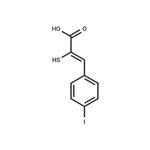PD-150606 (179528-45-1) is a selective, cell-permeable non-peptide calpain inhibitor (Ki for μ- and m-calpains = 0.21 and 0.37 μM respectively). Acts at the calcium binding site of calpain rather than the substrate-binding site. Inhibits calpain activity in two intact cell systems. Attenuates hypoxic/hypoglycemic injury to cerebrocortical neurons in culture and excitotoxic injury to Purkinje cells in cerebellar slices.1 PD-150606 displays cytoprotective effects in oxidant- and calcium ionophore-induced cell death.2 Some protective effects may be due to inhibition of MMP activity.3
PD 150606 is a novel mercaptoacrylate based compound and a potent inhibitor of Ca2+-dependent activation of calpain-1, a Ca2+-activated cytosolic cysteine protease. PD 150606 may potentially be developed as an anti-inflammatory agent. Neuroprotective product.
ChEBI: An organoiodine compound that is acrylic acid in which the vinylic hydrogens at positions 2 and 3 are replaced by mercapto and 4-iodophenyl groups respectively (the Z geoisomer).
PD 150606 is a selective; cell-permeable; non-peptide; uncompetitive calpain inhibitor.
1) Wang?et al. (1996),?An alpha-mercaptoacrylic acid derivative is a selective nonpeptide cell-permeable calpain inhibitor and is neuroprotective; Proc. Natl. Acad. Sci. USA,?93?6687
2) Waters?et al. (1997),?Calpains mediate calcium and chloride influx during the late phase of cell injury; J. Pharmacol. Exp. Therap.,?283?1177
3) Ali?et al. (2012), Calpain inhibitors exhibit matrix metalloproteinase-2 inhibitory activity; Biochem. Biophys. Res. Commun.,?423?1

